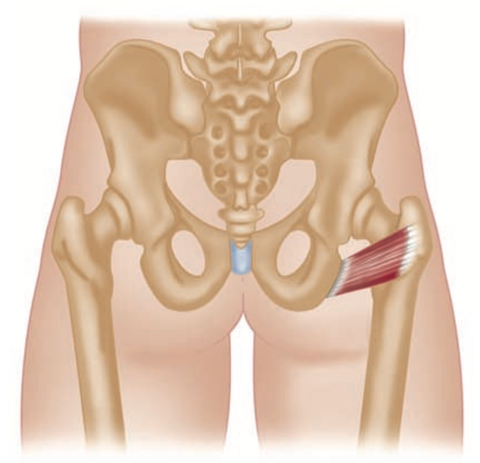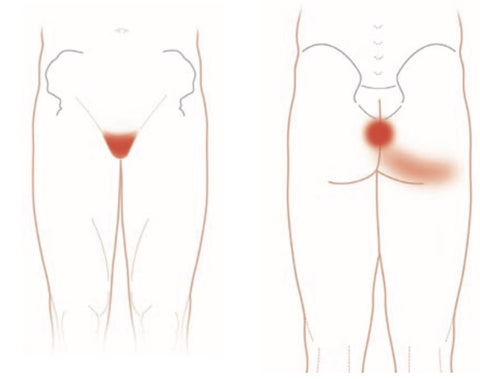Hip Extensors: Spotlight on Quadratus Femoris and Trigger Points
Understanding the Hip Extensors and Their Importance
As a manual therapist and athletic trainer, I’ve worked with countless clients dealing with hip pain, restricted mobility, or unexplained aches. Often, these issues can be traced back to the hip extensors, a group of muscles responsible for powerful movements like walking, running, and climbing stairs. These muscles also stabilize the pelvis and support the lower back, playing an integral role in everyday mobility and athletic performance.
The primary hip extensors include the gluteus maximus, hamstrings, and adductor magnus. However, the smaller, deeper muscles, such as the quadratus femoris, play equally vital roles in stabilizing the hip and assisting with lateral rotation. Understanding these muscles is key to addressing hip dysfunction effectively.
Meet the Quadratus Femoris: Anatomy and Function
The quadratus femoris is a short, flat muscle located deep in the posterior hip region. It spans from the ischial tuberosity (commonly referred to as the “sit bone”) to the intertrochanteric crest of the femur. Despite its small size, this muscle contributes significantly to stabilizing the hip joint and facilitating lateral rotation of the thigh.
In my practice, I often encounter cases where the quadratus femoris works overtime to compensate for weaknesses in surrounding muscles, such as the glutes or hamstrings. This overuse can lead to trigger points, which are localized areas of muscle tightness that can cause pain and dysfunction.
Recognizing Trigger Points in the Quadratus Femoris
Trigger points in the quadratus femoris can be tricky to identify due to their deep location. Clients often report vague, deep pain in the buttock or hip, sometimes radiating to the posterior thigh or knee. This referred pain can mimic other conditions, such as sciatica or piriformis syndrome, leading to misdiagnosis if the root cause isn’t thoroughly assessed.
Clients may also experience discomfort during activities like walking uphill, climbing stairs, or sitting for prolonged periods. This discomfort can sometimes be misinterpreted as joint pain, but a closer examination often reveals trigger points in the quadratus femoris.
What Causes Trigger Points in the Quadratus Femoris?
Trigger points in the quadratus femoris can develop for several reasons. Prolonged sitting on hard surfaces compresses the muscle, while overuse during repetitive lateral rotation can strain it. Weakness in other hip stabilizers often forces the quadratus femoris to overcompensate, leading to tightness and trigger points.
One common scenario is when a client’s gluteus maximus or hamstrings are weak, forcing the quadratus femoris to take on more stabilization work. This over-reliance sets the stage for trigger point development.

Treating Trigger Points in the Quadratus Femoris
Manual Therapy
Manual therapy is one of the most effective ways to address trigger points in the quadratus femoris. Techniques like ischemic compression, where sustained pressure is applied directly to the trigger point, can help release tight knots. Myofascial release targeting surrounding connective tissues is another valuable approach for improving mobility and reducing discomfort.
Massage Therapy
Massage therapy is a cornerstone of treatment. Gentle yet firm deep tissue massage targeting the posterior hip and gluteal region can alleviate tension in the quadratus femoris. Techniques such as active release, where the therapist applies pressure while the client moves the joint through its range of motion, can further enhance results.
Stretching and Mobility Work
Stretching exercises focused on external rotation and hip flexion are beneficial. A seated figure-four stretch or a modified pigeon pose can target the quadratus femoris effectively. Dynamic stretches, such as leg swings, help improve flexibility and prepare the muscle for further activity.
Trigger Points and Referred Pain
Trigger points don’t always cause pain at their source. In the case of the quadratus femoris, referred pain often radiates to the knee, making it easy to mistake for other conditions like patellofemoral pain syndrome.
For example, trigger points in the vastus medialis and lateralis muscles of the quadriceps can refer pain around the knee, creating confusion during diagnosis. Understanding this phenomenon is critical for effective treatment.
Advanced Therapies for the Quadratus Femoris
Dry Needling
Dry needling is a highly effective method for releasing trigger points in the quadratus femoris. By inserting thin needles into the muscle, we can stimulate blood flow, release tension, and reset the neuromuscular system. This technique, combined with manual therapy, often yields significant results.
Strengthening Exercises
Strengthening exercises for the glutes, hamstrings, and other hip stabilizers are essential for long-term relief. Movements like bridges, clamshells, and lateral band walks can help redistribute the load and prevent overuse of the quadratus femoris.

Comprehensive Hip Extensor Care
While the quadratus femoris plays a critical role in hip stabilization, addressing the entire hip extensor group is vital. Muscles like the gluteus maximus, hamstrings, and adductor magnus are often implicated in hip dysfunction and should be included in any comprehensive treatment plan.
Strengthening these muscles not only improves hip function but also supports the lower back and knees, creating a more stable and balanced movement system.
Conclusion: A Holistic Approach to Hip Health
The quadratus femoris may not get the spotlight as often as larger muscles like the gluteus maximus, but its role in hip stability and movement is undeniable. Recognizing and treating trigger points in this muscle can make a world of difference for clients experiencing hip pain or dysfunction.
As therapists, it’s our responsibility to adopt a holistic approach, addressing not only the immediate symptoms but also the underlying causes. By combining manual therapy, massage, stretching, and strengthening exercises, we can help clients achieve lasting relief.
If you’re a therapist looking to deepen your understanding of trigger point therapy, consider exploring the Trigger Point Therapist Diploma Course offered by Niel Asher Education. This course provides valuable insights and practical techniques to enhance your practice and improve outcomes for your clients.
Disclaimer
This article is for informational purposes only and should not replace professional medical advice, diagnosis, or treatment. Always consult a qualified healthcare provider for any concerns about your condition or treatment plan.
References
Travell, J. G., Simons, D. G., & Simons, L. S. (1999). Myofascial Pain and Dysfunction: The Trigger Point Manual. Lippincott Williams & Wilkins.
Clapis, P. A., Davis, S. M., & Davis, R. O. (2008). Reliability of inclinometer and goniometric measurements of hip extension flexibility using the modified Thomas test. Physiotherapy Theory and Practice, 24(2), 135-141.
Kendall, F. P., McCreary, E. K., & Provance, P. G. (2005). Muscles: Testing and Function with Posture and Pain. Lippincott Williams & Wilkins.
About Niel Asher Education
Niel Asher Education (NAT Global Campus) is a globally recognised provider of high-quality professional learning for hands-on health and movement practitioners. Through an extensive catalogue of expert-led online courses, NAT delivers continuing education for massage therapists, supporting both newly qualified and highly experienced professionals with practical, clinically relevant training designed for real-world practice.
Beyond massage therapy, Niel Asher Education offers comprehensive continuing education for physical therapists, continuing education for athletic trainers, continuing education for chiropractors, and continuing education for rehabilitation professionals working across a wide range of clinical, sports, and wellness environments. Courses span manual therapy, movement, rehabilitation, pain management, integrative therapies, and practitioner self-care, with content presented by respected educators and clinicians from around the world.
Known for its high production values and practitioner-focused approach, Niel Asher Education emphasises clarity, practical application, and professional integrity. Its online learning model allows practitioners to study at their own pace while earning recognised certificates and maintaining ongoing professional development requirements, making continuing education accessible regardless of location or schedule.
Through partnerships with leading educational platforms and organisations worldwide, Niel Asher Education continues to expand access to trusted, high-quality continuing education for massage therapists, continuing education for physical therapists, continuing education for athletic trainers, continuing education for chiropractors, and continuing education for rehabilitation professionals, supporting lifelong learning and professional excellence across the global therapy community.

Continuing Professional Education
Looking for Massage Therapy CEUs, PT and ATC continuing education, chiropractic CE, or advanced manual therapy training? Explore our evidence-based online courses designed for hands-on professionals.


















